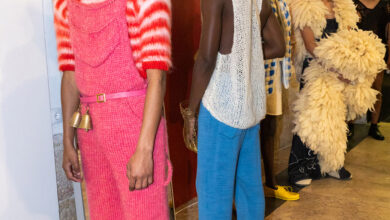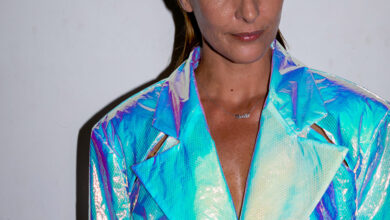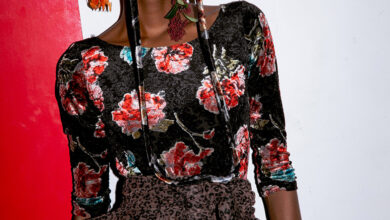DECO-TRON STYLE: HARDY AMIES A/W 2012-13
Savile Row, traditional British fabrics and “30s movies meet modernity in Hardy Amies” Autumn/Winter 2012-13 collection.
Text by Anna Battista
Films can be a great source of inspiration for a fashion designer. Yet if an inspiration is not cleverly elaborated it”s easy to fall into the trap of merely reproducing a costume from a specific movie rather than coming up with original and unique designs.
This certainly wasn”t the case with Hardy Amies” Autumn/Winter 2012-13 collection showcased in Florence during the Pitti event. Creative director Claire Malcolm moved indeed from Busby Berkeley”s aerial shots, sets and dancing routines to create abstract broken glass patterns replicated on jackets and trousers or creating web-like geometric motifs on shoes and suitcases. Traditional fabrics like tweed were instead turned around thanks to reflective threads creating optical illusion effects and representing a clash between iconic scenes such as the “Petting in the Park” number in Berkeley”s Gold Diggers of 1933 with the final can opener cutting through the armoured corset of one of the dancers to undress her, and more futuristic and contemporary films, to create what Malcolm describes as “Deco Tron”, a sort of Art Deco mood with a technologically advanced edge.
ZOOT MAGAZINE: How do you feel about being the creative director of a historical house such as Hardy Amies”?
Claire Malcolm: When I arrived at Hardy Amies”s house I felt as if I had found a goldmine. Amies was an amazing man and he truly did amazing things with his life. He designed dresses for the Queen, but, during World War II, he acted as a spy, so he was a sort of James Bond figure. I was really fascinated by this complex character and I felt more interested in him as a person and in his witty sense of style.
Z: What inspired this collection?
CM: I particularly love the “30s and in the archives of the house there are quite a few pictures of Amies at that time. There is this particular photo of him in a grey flannel suit that I found really inspiring. I love flannels and felt I wanted to take the flannel look and make the 21st century version of it.
 I also like movies and Amies designed all the costumes for Stanley Kubrick”s 2001: A Space Odyssey, but, while looking at the “30s for further inspirations, I watched Busby Berkeley”s Gold Diggers of 1933. This movie is set in America during the Great Depression, but Berkeley was very famous for producing these grand aerial shots that were really amazing at the time and used to have massive stage sets with hundreds of girls dancing and making all these beautiful patterns and shapes. I loved the movement in this film and I wanted to take references from that period and from Art Deco to create harsh geometric shapes that could make the wearer feel empowered. There is a part in the film in which the girls are wearing gold outfits and, after their number, the clothes are removed with a can opener. That”s where the metallic references in the collection came from.
I also like movies and Amies designed all the costumes for Stanley Kubrick”s 2001: A Space Odyssey, but, while looking at the “30s for further inspirations, I watched Busby Berkeley”s Gold Diggers of 1933. This movie is set in America during the Great Depression, but Berkeley was very famous for producing these grand aerial shots that were really amazing at the time and used to have massive stage sets with hundreds of girls dancing and making all these beautiful patterns and shapes. I loved the movement in this film and I wanted to take references from that period and from Art Deco to create harsh geometric shapes that could make the wearer feel empowered. There is a part in the film in which the girls are wearing gold outfits and, after their number, the clothes are removed with a can opener. That”s where the metallic references in the collection came from.
I always think about the suit as a modern day armour – you put the armour and you stand up straight and feel powerful – so the metallic references also hint at this “armoured” function in the collection.
Z: In which ways does this idea of protection that derives from armours also applies to the fabrics or the shapes and silhouettes employed in this collection?
CM: In terms of silhouettes I think it”s really important to have a good balance, so controlling the shape of a jacket without making it too tight and too stiff. In terms of fabric I”ve been playing with juxtapositions of soft matte flannels and placing them next to shiny and reflective materials. The trademark of this collection, the broken glass print with its strong geometric patterns, was replicated for example also on silk jackets.
We also incorporated a reflective fiber in the collection. This fiber is usually employed for safety purposes, but I wanted to use it in a way that still looked chic and comfortable. The reflective fabrics have great optical qualities and are made in Britain by a guy called Guy Hills, owner of the Dashing Tweeds company. He is a keen cyclist and in my mind he also embodies my interpretation of the brand that should be about a modern and young British gentleman. This special tweed we used doesn”t feel like an old fashioned classic tweed it looks extremely modern thanks to its technical qualities and it was really nice playing with it a bit. The reflective quality of these fabrics is mimicked by the polished effects on the shearlings that also look like flannels.
Z: Did you also apply the idea of empowerment and protection to the knitwear?
CM: We produced metal beaded knitwear just to get this feeling of armour and protection and also to tie in with the reflective theme of the collection. The knitwear is made by Corgi in Wales and I love working with them because they can make the most beautiful pieces and produce unique yarns such as a strong geelong that is still very soft. For this collection they recreated in some pieces very interesting asymmetric herringbone patterns.
Z: Are the fabrics you used mainly British?
CM: Yes, most of them are British. We worked for example with Fox Brothers & Co, an amazing English mill. They have thick books in their archives from the early 1900s with all the swatches indicating the date when they were created and the client who ordered them. I was so surprised to look at fabrics that had a great vibrancy and intricate motifs for those times so we recommissioned them again in a lighter version.
Z: What”s the main palette of choice for this collection?
CM: The collection is mainly grey since I wanted to strip it of colour to concentrate on the proportions and balance, but it also includes different patterns, from classic stripes and Prince of Wales to a diamond and broken glass pattern.
Z: For this collection you developed quite a few accessories in conjunction with other designers can you tell us more about them?
CM: The shoes – featuring nickel toecaps to make the wearer feel more empowered – are Mr Hare for Hardy Amies, while the cases are made in collaboration with Globe-Trotter. They were designed to capture Amies” essence: he spoke 5 or 6 languages and, as a young man, he travelled throughout Europe, so I wanted to call to mind the idea of a young modern man who is also a traveller.
Z: How would you define Hardy Amies” current image and are there any particular principles that you apply to your work that are directly borrowed from him?
CM: The image of Hardy feels a bit more glamorous, a bit more dandy, I would describe it as “minimal dandy”. The picture on the invitation of the show that inspired the mood for this collection portrays Hardy in a double-breasted shearling coat with cuff trousers, looking very glamorous. What”s interesting is that he wrote a book entitled The ABC of Men”s Fashion, but when you read it, you realise that he constantly breaks his own rules. In this book he says for example “never wear cuffs”, but then you have so many images of him in the archive with cuff trousers.
I really liked the idea that Savile Row is essentially about rules, while fashion is about breaking rules and Hardy had that balance. So I”ve been trying to play a bit with his rules: for example he said “never wear shorts”, but last season the whole show was with shorts and this was because I wanted to subvert his rules but within the confines of Savile Row. In this collection every trouser has a cuff and we have a slightly wider legged trouser with a double pleat just to give more volume to the trousers and make the wearer feel more glamorous.
Z: According to you, in which ways has the Savile Row look evolved?
CM: The English look constantly evolves. For me modernity is about tailoring that is comfortable yet still keeps a beautiful shape. Lots of people can produce a single-breasted jackect, but when you see a man wearing a jacket like the ones in this collection, you realise that each part of it, from the shoulders to the sleeves, fits beautifully, and that”s something special. For this collection I wanted to keep this hourglass Savile Row silhouette for what regards shapes, but I wanted to shorten the jacket slightly.
Z: Would you ever do womenswear?
CM: As a company we would love to do womenswear, but at the moment our focus is on developing our menswear.
All images by Gabriele Semeraro














